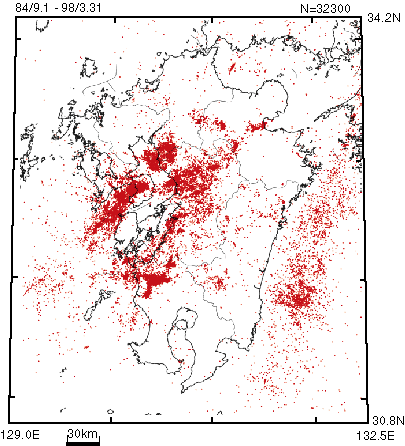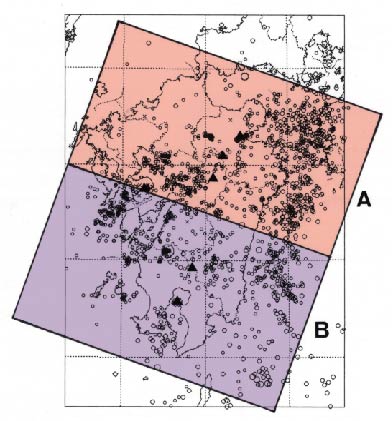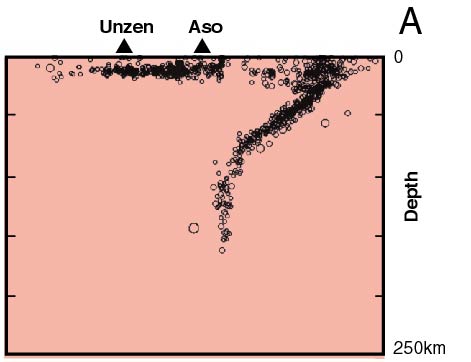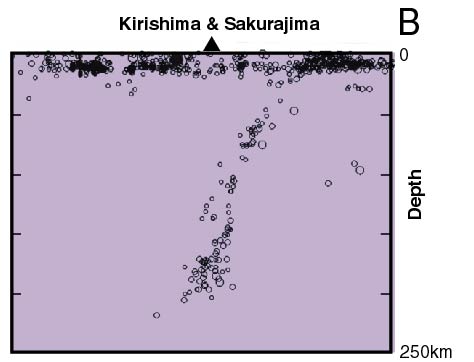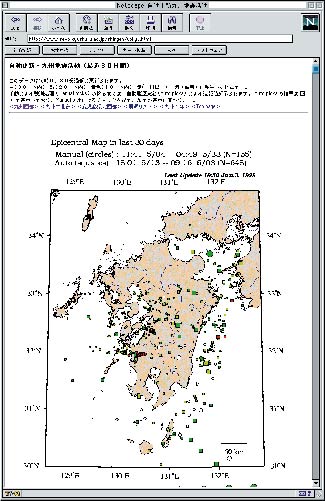  Top of Part 4
Top of Part 4
  Previous p.
Previous p.
  Next page
Next page
|
 Earthquakes in the Kyushu Island Earthquakes in the Kyushu Island
 fall into two groups. fall into two groups.
 One is crustal One is crustal
 earthquakes which occurr earthquakes which occurr
 shallower than 30 km in depth, shallower than 30 km in depth,
 and the other is and the other is
 those associated those associated
 with subduction of with subduction of
 the Philippine Sea plate the Philippine Sea plate
 into the mantle under into the mantle under
 the Kyushu Island. the Kyushu Island.

 The zone extending The zone extending
 from Beppu through Kuju, from Beppu through Kuju,
 Aso, and Unzen volcanoes Aso, and Unzen volcanoes
 to the Sea of Amakusa, to the Sea of Amakusa,
 called "Beppu-Shimabara graben", called "Beppu-Shimabara graben",
 and the belt along the and the belt along the
 coast of the Ariake coast of the Ariake
 and the Yatsushiro Sea and the Yatsushiro Sea
 are both seismically very are both seismically very
 active. active.

 Moreover, the Satsuma region, Moreover, the Satsuma region,
 northwest of the Kagoshima northwest of the Kagoshima
 Prefecture, Prefecture,
 recently becomes recently becomes
 very active with very active with
 a few hazardous a few hazardous
 inland earthquakes of inland earthquakes of
 magnitudes around 6. magnitudes around 6.

 Focal mechanisms of Focal mechanisms of
 crustal earthquakes crustal earthquakes
 in the Beppu-Shimabara graben in the Beppu-Shimabara graben
 indicate north-south indicate north-south
 or northwest-southeast or northwest-southeast
 extension of the crust of the extension of the crust of the
 Kyushu Island. Kyushu Island.

 The earthquakes associated The earthquakes associated
 with subduction of with subduction of
 the Philippine Sea plate the Philippine Sea plate
 occur in a seismic zone occur in a seismic zone
 inclining steeply inclining steeply
 from the Sea of Hyuga from the Sea of Hyuga
 toward the toward the
 deep mantle beneath deep mantle beneath
 the Kyushu Island. the Kyushu Island.
 This distribution of hypocenters This distribution of hypocenters
 seems to show the aspect seems to show the aspect
 of the subducting of the subducting
 Philippine Sea plate Philippine Sea plate
 in the mantle. in the mantle.

 Big earthquakes Big earthquakes
 of magnitudes around 7 of magnitudes around 7
 occur once a decade occur once a decade
 in the Sea of Hyuga, in the Sea of Hyuga,
 which often accompanies tunamis. which often accompanies tunamis.

|

 Top of Part 4
Top of Part 4

 Previous p.
Previous p.

 Next page
Next page
 Earthquakes in the Kyushu Island
Earthquakes in the Kyushu Island
 fall into two groups.
fall into two groups.
 One is crustal
One is crustal
 earthquakes which occurr
earthquakes which occurr
 shallower than 30 km in depth,
shallower than 30 km in depth,
 and the other is
and the other is
 those associated
those associated
 with subduction of
with subduction of
 the Philippine Sea plate
the Philippine Sea plate
 into the mantle under
into the mantle under
 the Kyushu Island.
the Kyushu Island.

 The zone extending
The zone extending
 from Beppu through Kuju,
from Beppu through Kuju,
 Aso, and Unzen volcanoes
Aso, and Unzen volcanoes
 to the Sea of Amakusa,
to the Sea of Amakusa,
 called "Beppu-Shimabara graben",
called "Beppu-Shimabara graben",
 and the belt along the
and the belt along the
 coast of the Ariake
coast of the Ariake
 and the Yatsushiro Sea
and the Yatsushiro Sea
 are both seismically very
are both seismically very
 active.
active.

 Moreover, the Satsuma region,
Moreover, the Satsuma region,
 northwest of the Kagoshima
northwest of the Kagoshima
 Prefecture,
Prefecture,
 recently becomes
recently becomes
 very active with
very active with
 a few hazardous
a few hazardous
 inland earthquakes of
inland earthquakes of
 magnitudes around 6.
magnitudes around 6.

 Focal mechanisms of
Focal mechanisms of
 crustal earthquakes
crustal earthquakes
 in the Beppu-Shimabara graben
in the Beppu-Shimabara graben
 indicate north-south
indicate north-south
 or northwest-southeast
or northwest-southeast
 extension of the crust of the
extension of the crust of the
 Kyushu Island.
Kyushu Island.

 The earthquakes associated
The earthquakes associated
 with subduction of
with subduction of
 the Philippine Sea plate
the Philippine Sea plate
 occur in a seismic zone
occur in a seismic zone
 inclining steeply
inclining steeply
 from the Sea of Hyuga
from the Sea of Hyuga
 toward the
toward the
 deep mantle beneath
deep mantle beneath
 the Kyushu Island.
the Kyushu Island.
 This distribution of hypocenters
This distribution of hypocenters
 seems to show the aspect
seems to show the aspect
 of the subducting
of the subducting
 Philippine Sea plate
Philippine Sea plate
 in the mantle.
in the mantle.

 Big earthquakes
Big earthquakes
 of magnitudes around 7
of magnitudes around 7
 occur once a decade
occur once a decade
 in the Sea of Hyuga,
in the Sea of Hyuga,
 which often accompanies tunamis.
which often accompanies tunamis.

